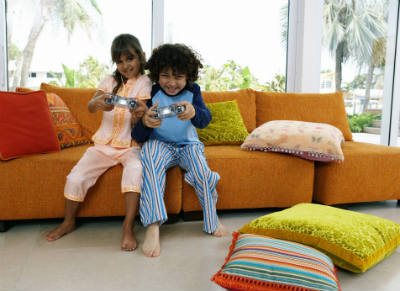If you’re wondering whether your child may be spending too much time playing video games, there is an excellent test to double check yourself at PsychologyToday.com.  You’ll answer 25 questions, either “yes” or “no.” Here are three of the questions:
You’ll answer 25 questions, either “yes” or “no.” Here are three of the questions:
- Does your child seem revved up much of the time?
- Do you worry that your child’s interests have narrowed recently, or that interests mostly revolve around screens? Do you feel his or her thirst for knowledge and natural curiosity has been dampened?
- Do you and your child argue over screens (limits, timing, content, activities, getting a new device, etc.) on a regular basis?
Add up your “yes” answers and check the chart in the article to see where your child falls on the Electronic Screen Syndrome (ESS) spectrum. ESS is a state where your child’s nervous system has become overstimulated by excessive screen time. This “causes the brain to be in a state of chronic stress and effectively short circuits the frontal lobe, creating a host of symptoms that mimic or exacerbate mental health, learning, and behavioral disorders.”
What’s especially nice about this test is that you can also see the specific areas where your child is being negatively affected, perhaps in mood or social skills. The article suggests a three-week or more “fast” from electronics to reset your child’s nervous system.
Perhaps, though, your child’s usage of screen time hasn’t yet reached a critical level and you want to proactively set screen time limits. If so, CNN.com lists recommendations for young children from the American Academy of Pediatrics (AAP), which states that if your child is 18 months or younger, he or she should not be exposed to screens. This is important to allow babies’ brains to develop and for healthy parent-child time to occur.
Note: the AAP has changed how it defines screen time limits, focusing on children using digital media for video games and other entertainment. Time spent, for example, doing online homework doesn’t count as screen time.
For children aged 2 to 5, the recommendation is a limit of one hour per day. AAP suggests that parents “prioritize creative, unplugged playtime” and choose quality shows such as Sesame Street for the digital time. They don’t recommend animated shows, as young children in this age bracket can’t yet decipher between fictional cartoons and real people. AAP does believe that interactive media, such as Skype and Facebook, can be healthy, perhaps to connect with Grandma. After one of these conversations ends, parents can repeat what Grandma said to supplement learning.
Once children are six, AAP suggests that parents determine screen time limits, as well as the types of digital media their children are using. It’s important to make sure there’s enough time for “school, homework time, at least one hour of physical activity, social contact and sleep.” In time that’s left over, parents can decide limitations for the family. Parents should also serve as mentors as they teach their children how to use digital media to “create, connect and learn.”
Reasons to Limit Screen Time for the Whole Family
CBS.com lists multiple reasons why limitations make good sense for everyone in the family, not just young children, including that too much screen time can lead to weight gain. You don’t get enough exercise while sitting in front of a screen and you’re probably watching lots of commercials for fast food, candy and more. Screen time can also make children feel lonely, imagining what friends are doing while they’re reading social media posts. Screen time can make you tired and playing too many video games can even lead to injuries, from “gamer’s thumb” to neck and back pain, dry eyes and more.
So, limit screen time for everyone in the family and spend more time connecting with one another and with the great big wide world out there!




